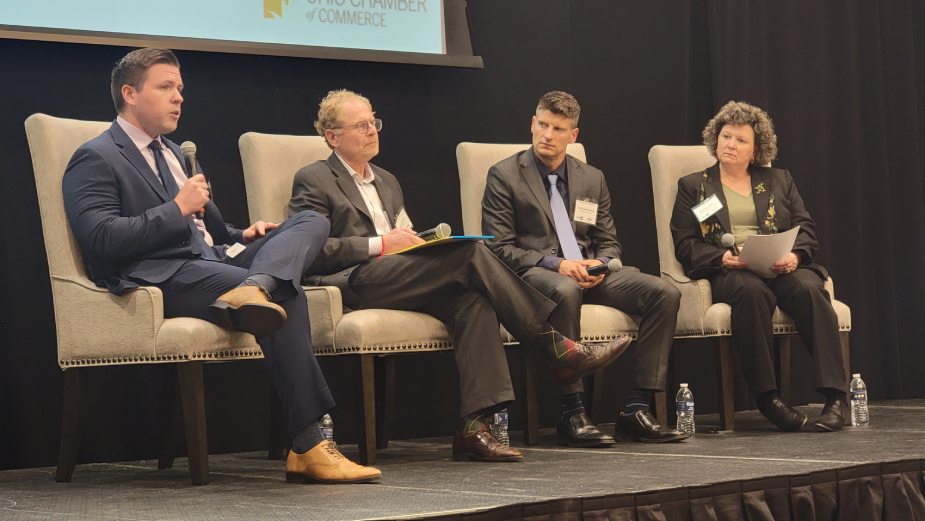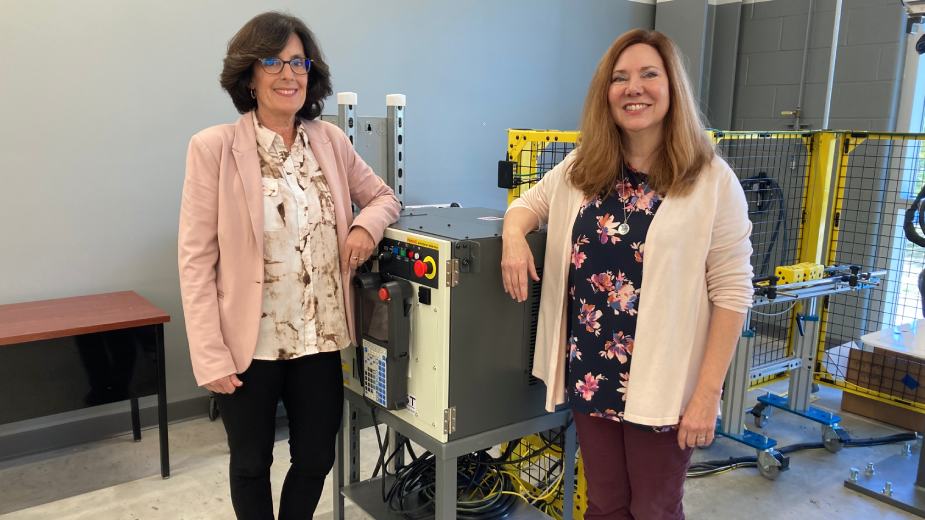To Fill Future Jobs, Repopulate the Valley
CANFIELD, Ohio — Ohio and the Mahoning Valley are on the verge of an economic boom, but more work needs to be done to ensure there are enough workers to fill those jobs.
That was a theme Sept. 28 at “Repopulating the Valley to Meet Workforce Needs,” a panel discussion at 2023 Mahoning Valley Regional Impact Ohio.
The event was sponsored by the Youngstown/Warren Regional Chamber, Impact Ohio and the Ohio Chamber of Commerce and presented by JobsOhio. Brenda Linert, editor of the Tribune Chronicle and The Vindicator, moderated the discussion.
“Ohio is going through a demographic transition,” said Eric Leach, deputy director of the Ohio Governor’s Office of Workforce Transformation, who was one of the panelists. “Ohio throughout its history has always experienced population growth and that was true up until our most recent projections.”
A recent demographic study from the Ohio Department of Development forecasts a 5.7% Ohio population decrease by 2050. That’s a loss of about 675,000 people.
It’s not because of migration. In fact, from 2010 to 2020, more people moved into the state than moved out.
Three factors figure into population growth, Leach said: Births, deaths and migration.
“Although we have a positive net migration, our birth rate, our fertility rate, is declining,” Leach said. “From 2010 to 2020, we had around an 18% decline in fertility. In order to have population growth, you have to have 2.1 births. In Ohio, we’re about 1.72.”
The state’s mortality rate is increasing — more younger people are dying. Leach pointed to covid effects and the opioid crisis as contributors.
“At the same time, our economic growth is accelerating,” he said. “Ohio is going through a huge renaissance right now.”
Gov. Mike DeWine and Lt. Gov. John Husted have made it a priority for the Office of Workforce Transformation to focus on demographics, Leach said.
“Demography is destiny,” he added. “Northeast Ohio is going to have huge growth in jobs in advanced manufacturing…,” Leach said. “We’re projecting over 25,000 new jobs in Ohio by 2030 in electric vehicles and about half of them are in northeast Ohio. To have the job growth, we need the people.”
One way to address that is through internships for both high school and postsecondary students with the state providing reimbursement to the companies. It’s up to $5,000 in state reimbursement per high student intern and up to $7,500 per college or university student intern. For high school students the internships are in the technology field.
Repopulation is a focus of the Regional Chamber, which is working with the Eastgate Council of Regional Governments.
Another panelist, Emil N. Liszniansky, principal with Envision Group LLC of Cleveland, said repopulation strategy requires a three-pronged approach.
He called it the three Rs of repopulation: retain existing talent, return homegrown talent that has left the area and recruit new residents with an emphasis on global populations.
“This could be humanitarian parolees like the Ukrainian situation, refugees or immigrants,” Liszniansky said.
The third panelist, Ed Kraus, mayor of Solon in Cuyahoga County, said that several years ago Solon city officials rezoned a large portion of land industrial as a step in creating what he called an ecosystem.
“That was many, many years ago and it really paid off,” he said. “A lot of the aging companies in Cleveland then moved. We have about 900 businesses now. Unlike my colleagues who decided to focus on office and retail — we all know the future of office and retail as far as banking your economy on — we focused on manufacturing and industrial.”
Nestle and Swagelok, a company that manufactures fittings for transportation industries, are among the companies located in Kraus’s city. The businesses are focused on innovation and technology, he said.
Another issue Solon had to address was transportation. About 20% of Cuyahoga County’s population doesn’t have reliable transportation and many of those who work in Solon’s manufacturing jobs live in Cleveland.
If they take the public transportation system, the commute can take up to 90 minutes one way, the mayor said.
“We decided to partner with our businesses so we came up with a concept called the Solon Mobility Task Force,” Kraus said.
People are picked up and transported to the companies where they work.
Also, about 30% of Solon’s population is foreign born.
“That creates challenges, but it creates amazing opportunities,” Kraus said. “About 15% of our population is Chinese and about 10% from India. What happens is we get a lot of international companies because they recruit right from China. They recruit directly from India and we incentivize those companies internationally.”
Schools also play a big role.
“You have to have a quality education system because that’s what keeps talent,” Kraus said. “That’s what brings companies in.”
Leach added that there’s a lack of qualified instructors across the state in industry.
“Because of the labor market and the tightness in it, institutions can’t afford the traditional qualified instructors who may be retired or doing it part time,” he said. “What we really need is business and industry to partner with our educational institutions to offer up some of those qualified instructors.”
Kraus said a lot of the credit for Solon’s success goes to the companies themselves. Swagelok, for example, developed its own sort of university and recruits students.
“They teach them the technology. They teach them how to make the fittings and they do it in house. The recruitment becomes a lot easier,” he said. “…I think the companies became a lot smarter.”
Housing is another challenge.
Leach said that statewide there aren’t enough permits being issued for new housing starts. That’s locally driven, he said.
Kraus said cities need to be smarter in diversifying their housing to attract talent. Some cities were designed for single-family homes, but that’s not what a lot of younger people want.
“I have three kids, all in their 20s, not one of them wants the lifestyle that my wife and I have,” he said. “They want a completely different lifestyle.”
Solon started to consider apartments.
“Years ago, if you talked about apartments, people screamed at you,” Kraus said. “All they thought about was Section 8 or affordable housing. A lot of people want to live in apartments, nice apartments with nice amenities where you could walk to a coffee shop, to a bar and have it all within walkable areas.”
Others want townhomes.
“If they want to attract talent, they have to be smart about diversifying the housing options,” Kraus said. “This generation, that’s what they want.”
Liszniansky said Eastgate Regional Council of Governments is embarking on a regional housing strategy to address those issues.
“I think Eric and the mayor both nailed basically the scope elements, kind of changing that mindset that single-family detached on half-acre lots is not the normal trend now,” he said. “It’s not how we’re going to attract workforce and we’re going to have to think about density which can be a bad word sometimes in local zoning, especially referendum zoning.”
Liszniansky said it also involves putting housing near transit so people don’t necessarily have to drive to work.
“There needs to be an education that without the housing to meet the workforce needs, we’re not going to get the workforce,” Liszniansky said. “For the companies that are here today, when the new companies, like a Foxconn or an Ultium, need to hire people, they’re going to hire employees from those companies if we don’t build more housing. I think we need to explain that.”
Companies also look at quality of life issues like parks and walking trails, Kraus said.
“First you think it’s just for the residents, but the reality is businesses want that,” he said.
It drives economic development, Kraus said.
Liznianasky said infrastructure in the community also must be modernized to accommodate population growth.
Adding more green spaces, improving access to the Mahoning River and adding more mixed-space developments in town centers will also help attract young people and talent.
Leach said the labor force participation rate is also key. In Ohio it’s about 62% percent, close to pre-pandemic levels.
“Labor force participation is going to be the biggest driver of whether or not we’re going to be able to fill all the jobs that we have and are going to have,” he said.
Because of the lower birth rate in Ohio and more people dying at a younger age, “we have to make sure that every Ohioan who is of working age is as economically productive as we can get them,” he said.
That means focusing on second-chance hiring. People who are being released from prison need to be trained. That helps those individuals and also the workforce.
Liszniansky said the region is eligible for funding through the Appalachia Community Grant Program.
“We are looking at an integrated lake-to-river four county initiative — Ashtabula, Trumbull, Mahoning and Columbiana — that’s going to look at workforce development, talent attraction, place making and a welcome center that will include not just new Americans but also those that may have been forgotten,” he said.
That includes people coming back from incarceration, people coming back from addiction, people with disabilities.
Pictured at top: Eric Leach, deputy director of the Governor’s Office of Workforce Development; Solon Mayor Ed Kraus; and Emil N. Liszniansky, principal with the Envision Group LLC of Cleveland, discuss “Repopulating the Valley to Meet Workforce Needs” Sept. 28 at 2023 Mahoning Valley Regional Impact Ohio. Brenda Linert, editor of the Tribune Chronicle and The Vindicator, moderated the discussion.
Copyright 2024 The Business Journal, Youngstown, Ohio.



